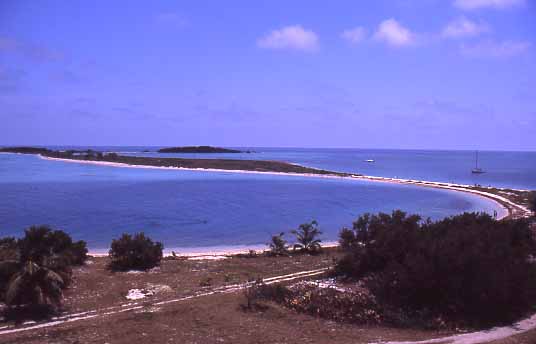
Cruising Florida's Dry Tortugas
By Barbara Theisen
With full sails, Out of Bounds headed northeast. We rounded the end of Isla Mujeres, off the Yucatan Coast of Mexico, just as the sun sank into the western Caribbean. Our destination was the U.S. and we hoped to make landfall in the Dry Tortugas, approximately 300 miles away.
As darkness fell, we took a more westerly heading, hoping to pick up some push
from the northbound current that would soon become the mighty Gulfstream.
Several cruise ships dotted the horizon. We settled into the routine of our
watches with husband Tom and daughter Kate taking the midnight to 4 AM shift.
 |
| A solid isthmus has formed between Garden Key and Bush Key closing the channel. |
Two and a half days later, the anchor sank into the soft sand off Garden Key in
the Dry Tortugas, just as the sun rose over Fort Jefferson.
The Dry Tortugas lie about 70 miles west of Key West and are accessible only by
boat or seaplane. The seven keys and surrounding coral reefs make up Fort
Jefferson National Park. These keys are isolated and there are no places to fuel
or provision here. But beauty, wildlife and great diving abound.
Ponce de Leon discovered these tiny islands in 1513 while on his famous quest
for the Fountain of Youth. He called the area Las Tortugas for the large number
of sea turtles that inhabited the islands. Later, the area became known as the
Dry Tortugas, as the word "dry" was a warning to sailors that no fresh water was
to be found here.
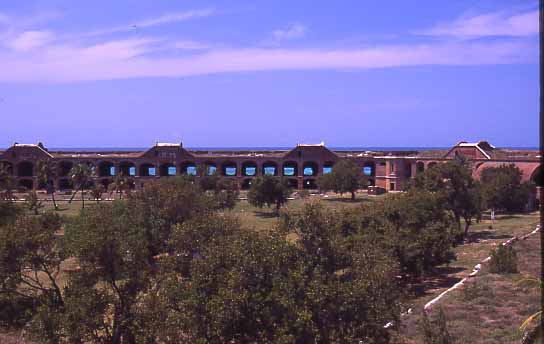 |
| Fort Jefferson |
Pirates enjoyed the isolation of the islands until 1821 when Florida became part
of the US and the pirates were finally driven out. In 1825 a lighthouse was
erected on Garden Key to warn of the shoals and reefs, which had sunk a great
number of ships.
Then in 1846 the strategic location of the Dry Tortugas was recognized and the
construction of Fort Jefferson was begun. It took some 30 years and 16 million
bricks to build the hexagon shaped fort, although it never was completely
finished. In 1856 the present lighthouse on Loggerhead Key was built, making it
the southernmost lighthouse in the continental US.
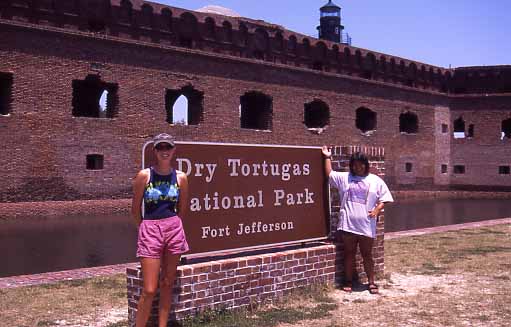 |
| Kate and Kenna in the Dry Tortugas. |
Federal troops occupied the fort during the Civil War where the fort served as a
military prison. The most famous prisoner was Dr. Samuel Mudd, a physician who,
not knowing of Lincoln's murder, set the broken leg of John Wilkes Booth. Dr.
Mudd was sentenced to life in prison for this act.
Epidemics of yellow fever swept the fort during this time, but the efforts of Dr. Mudd saved hundreds of lives and he was pardoned in 1869. Through the efforts of his family, he was finally absolved of all guilt in 1979, 110 years after his sentencing.
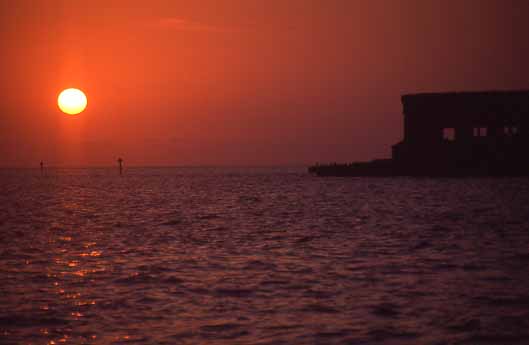 |
| Sunrise over Fort Jefferson. |
Next Fort Jefferson became a naval base. In 1898, the battleship USS Maine left
the Dry Tortugas and headed to Havana, Cuba on her fateful voyage. A year later
the ship was blown up, an event which started the Spanish-American War. The fort
also served as a coal station and a World War I seaplane base. Although its
importance as a military base waned, it's value as a natural resource grew. John
Audubon visited the Dry Tortugas in 1832 and the area was made a marine
sanctuary in 1908. In 1935 it was designated as a National Monument and in 1992
it became a National Park. Today the area is known for its abundant bird and
marine life, its legends of pirates and sunken gold, and of course, for its
incredible, unspoiled beauty.
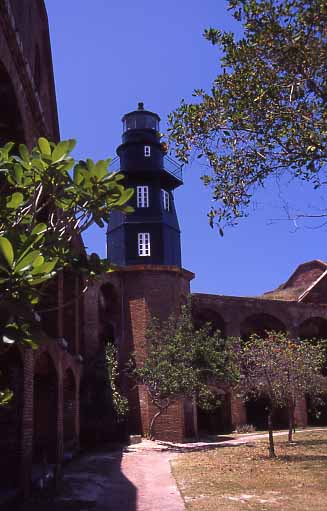 |
| The Garden Key Light. |
After catching a few hours of sleep, we headed over to the Park Headquarters
inside Fort Jefferson. We had hoped that we would be able to clear customs here,
which in our past experience of returning to the US, was simply done by calling
a toll free telephone number. However, there are no phones anywhere in the Dry
Tortugas. So instead we took the self-guided tour of the fort, relishing the
coolness inside the eight-foot-thick brick walls.
This is America's largest coastal fort and it dominates the entire key. It is
completely surrounded by a moat. Looking out the fort's windows is an amazing
view of turquoise waters studded with coral reefs. The self-guided tour was easy
to follow; you just follow the signs with the Civil War soldier on them. We
toured all three levels of the fort. We saw soldiers' barracks, officers'
headquarters, prisoners’ quarters including Dr. Mudd's cell, cisterns, the
chapel and more. From the top of the fort you can see the surrounding keys with
bird rookeries as well as the cannons.
Ranger led tours are also sometimes offered and schedules will be posted in the
park headquarters. A lantern walk through the fort may be scheduled on some
evenings as well.
We also spent time enjoying the underwater scenery of the Dry Tortugas. Our
favorite was an afternoon spent snorkeling/scuba diving on a shipwreck near
Loggerhead Key called "the windjammer." Visibility was fantastic and the wreck
was encased in a colorful array of corals. Hidden under the bow of the
windjammer was the largest jewfish (relative of the grouper) we had ever seen.
He must have been at least seven feet in length! He eyed us warily but didn't
seem overly concerned with our presence.
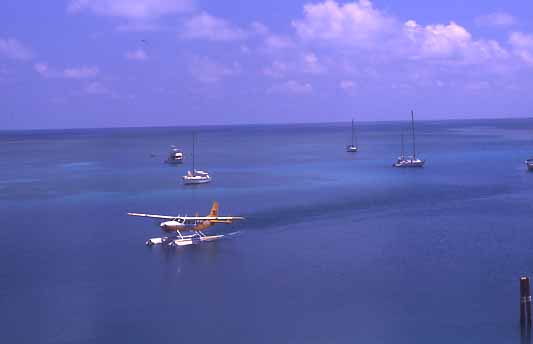 |
| The Dry Tortugas are only accessible by boat or sea plane. |
Although several "fast" ferryboats and several seaplanes make daily trips from
Key West to the Dry Tortugas, tourists remain at Garden Key where they can tour
Fort Jefferson and snorkel the reefs that surround the key. Every place else
that we visited in the park was virtually deserted.
Several of the keys in the Dry Tortugas are off limits during the nesting season
between March and September when some 100,000 sooty terns call Bush Key home.
Disturbing the nest can be death for young birds. Brown and black noddies also
nest in the vegetation between the sootie's rookery. While Bush Key is closed
during the nesting season, Hospital and Long Keys are closed to visitors all
year. All keys, with the exception of Garden Key (where Fort Jefferson is
located) are open only during daylight hours.
Some of the other birds that are likely to be spotted include the magnificent
frigate birds with their huge seven-foot wingspan, masked boobies, brown
boobies, double-crested cormorants, brown pelicans and roseate terns.
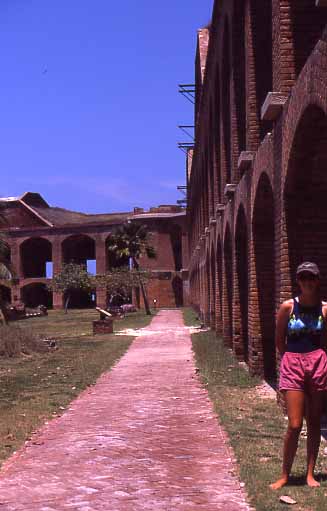 |
| Kate inside of Fort Jefferson. |
Underwater you are likely to see the green turtle and the loggerhead turtle for
which the Dry Tortugas were named.
If you plan on sailing to the Dry Tortugas be sure to prepare your boat well.
You will need to bring everything you need with you, as you will not be able to
obtain supplies, water or fuel. There is no dockage and no moorings available.
If you are taking off from Florida, wait for favorable wind and weather. The
70-mile trip can be done in about 12 hours or so. If you have a shoal draft boat
and the weather is settled you can make a stop in the Marquesas, which are
located only 24 miles from Key West.
When approaching Garden Key from the north, be advised that the channel between
Garden and Bush Keys is now completed closed in. A winter storm recently formed
a solid isthmus between the two keys. Most charts and guidebooks still show the
channel heading between Garden and Bush Key and recommend the channel as a way
to enter the anchorage at Garden Key in front of the fort. Now you will need to
round the fort and enter at Garden Key's southerly entry channel. You can anchor
in 13 to 20 feet of sand. You can also anchor "behind" the fort in settled
weather. Park regulations state that all boats in the park must be anchored
within one mile of Garden Key between dusk and dawn. Fishing is allowed in the
park but spearfishing or the taking of lobsters is forbidden.
The Dry Tortugas were a great stop for us coming back to the states from the
laid back atmosphere of Central America. Their isolation and serenity would be
in sharp contrast to our next stop - Key West.
Barbara Theisen has spent the past thirteen years living aboard Out of Bounds
with her husband Tom and daughters, Kate and Kenna. For more information on
living the cruising life visit the Theisen's Website at www.TheCruisingLife.com.